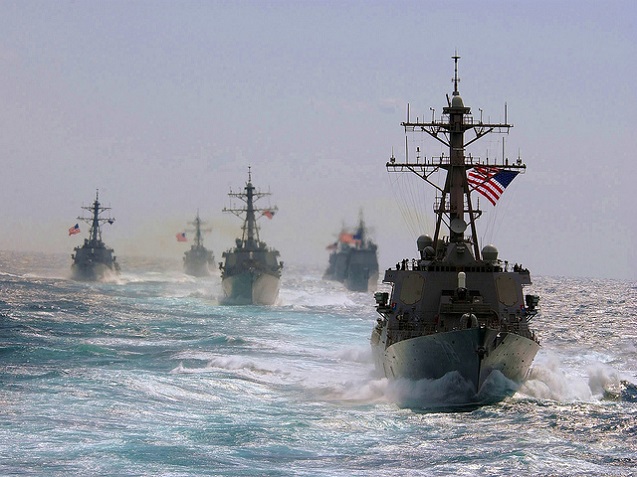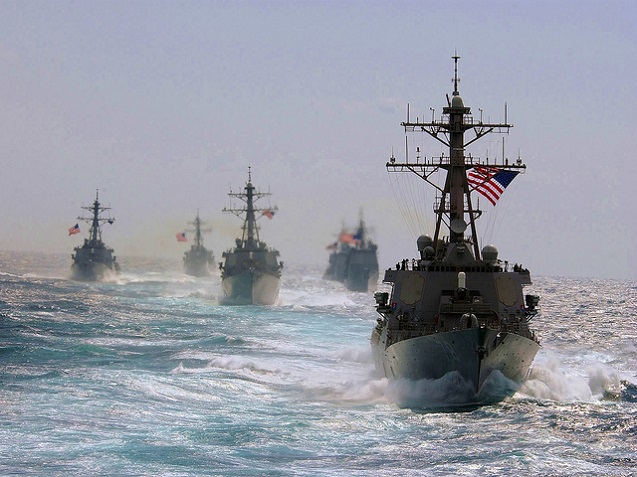
 Guided missile destroyers USS Porter (DDG 78) – USS McFaul (DDG 74) – USS Arleigh Burke (DDG 51) – USS Cole (DDG 67). Guided missile cruisers USS Cape St. George (CG 71) and USS Anzio (CG 68). Assigned to Commander, Carrier Strike Group 12. Photo by Lt. j.g. Caleb Swigart, U.S.N. (Photo: Greg Bishop / Flickr)
Guided missile destroyers USS Porter (DDG 78) – USS McFaul (DDG 74) – USS Arleigh Burke (DDG 51) – USS Cole (DDG 67). Guided missile cruisers USS Cape St. George (CG 71) and USS Anzio (CG 68). Assigned to Commander, Carrier Strike Group 12. Photo by Lt. j.g. Caleb Swigart, U.S.N. (Photo: Greg Bishop / Flickr)
On the morning of October, 12, 2000, the USS Cole, a US Navy Destroyer, docked in the Aden harbor of Yemen. What would seem like a normal refueling of a naval ship turned tragic. That morning, a small boat headed toward the destroyer’s port side and exploded, blasting open a 40-foot-wide hole. It left 17 sailors dead and injured 39 others.
It was later learned that the Islamic terrorist group al-Qaeda was responsible for the suicide attack. Several individuals were suspected of masterminding the attack. Abu Ali al-Harithi, a Yemeni citizen and al-Qaeda leader, was one suspect. On November 3, 2002, he was killed by a CIA drone strike in Yemen, along with Kamal Derwish, a US citizen traveling with him. This was the first time a drone strike was used to kill suspected terrorists outside of Afghanistan. It was also the first time a US citizen was killed, without due process, by an armed drone in the global War on Terror, even though he was not the target.
Read more stories about Guantanamo at the Caging Human Rights series on Truthout.
Jamal al-Badawi is also alleged to have been one of the masterminds of the USS Cole bombing. In April 2003, al-Badawi escaped from Yemeni custody. Al-Badawi was captured by Yemeni authorities in March 2004 and sentenced to death in September of that year. On February 3, 2006, al-Badawi escaped from prison, again, along with 22 others, many of whom were suspected al-Qaeda fighters. He handed himself in to Yemeni authorities in October 2007. Two weeks later, he was released after pledging allegiance to Yemen’s then-president Ali Abdullah Saleh, US ally in the War on Terror and a harsh dictator overthrown by the Yemeni people.
Walid bin Attash (also known as Tawfiq bin Attash), also Yemeni, is another alleged mastermind of the USS Cole bombing. He lost his right leg in 1997 while fighting the Northern Alliance in Afghanistan and joined al-Qaeda soon after that battle. On April 29, 2003, Attash and Ali Abdul Aziz Ali were captured in Karachi, Pakistan. For three years, Attash was held in a CIA black site and subjected to stress positions. In 2006, he was transferred to Guantanamo Bay prison.
The latest suspected mastermind of the 2000 USS Cole bombing is Abd al-Rahim al-Nashiri. The charges against al-Nashiri are perfidy, murder in violation of the law of war, attempted murder in violation of the law of war, terrorism, conspiracy, intentionally causing serious bodily injury, attacking civilians, attacking civilian objects and hijacking a vessel. They relate to the 2000 USS Cole bombing, the attempted attack on the USS The Sullivans in January 2000 and an attack on the MV Limburg in October 2002. He faces the death penalty and is currently being tried in a military commission at Guantanamo Bay. Pretrial hearings were held from June 11 to June 14.
Al-Nashiri’s alleged crimes are horrific. But his backstory raises questions about the consequences and dark side of US foreign policy. The Soviet occupation of Afghanistan and the US proxy war in that country against the USSR provide context for Abd al-Rahim al-Nashiri’s story.
For nearly 40 years, the United States was mired in a bitter Cold War against the Soviet Union. It was characterized by several proxy wars throughout the so-called Third World, with the Soviets backing movements for national liberation (many of which were more concerned with self-determination and overthrowing Western colonialism than implementing state socialism and aligning with the Soviets), while the United States supported brutal right-wing political elements, such as authoritarian, Western-friendly governments or US-trained and armed proxy forces (such as the Contras in Nicaragua).
There were some large-scale conventional wars, particularly the war in Vietnam. However, proxy wars and covert operations dominated the Cold War landscape.
A notable proxy war took place in Afghanistan during the 1980s. In 1979, the Soviet Union invaded Afghanistan in response to an insurgency against the Afghan government. This was a year after the communist People’s Democratic Party of Afghanistan (PDPA) seized power in Afghanistan during the Saur Revolution. Zbigniew Brzezinski, national security adviser to then-President Jimmy Carter, told Carter, “We now have the opportunity of giving to the USSR its Vietnam War.” This involved giving covert aid, in the form of money and weapons, to the mujahideen, a group of Afghan Muslim guerrillas, fighting against the Soviets in Afghanistan, an idea advanced by Bzrezinski.
In a 1998 interview with the French weekly Le Nouvel Observateur, Bzrezinski said that US covert aid to the mujahideen began months before the Soviet invasion and even enticed it. “Indeed, it was July 3, 1979,” explained Bzrezinski, “that President Carter signed the first directive for secret aid to the opponents of the pro-Soviet regime in Kabul. And that very day, I wrote a note to the president in which I explained to him that in my opinion this aid was going to induce a Soviet military intervention.” He qualified, “We didn’t push the Russians to intervene, but we knowingly increased the probability that they would.” This action was designed to “make the Soviets bleed for as much and as long as is possible.”
Through a covert operation called “Operation Cyclone,” the United States provided money and weapons to the mujahideen through Pakistan’s Inter-Services Intelligence (ISI), the country’s notorious secret intelligence agency. Pakistan’s ISI was chosen as the middleman to disguise the source of support. Moreover, the ISI shared the United State’s interest in backing the mujahideen against the Soviets but wanted a government in Afghanistan friendly to Pakistan’s interests. Other countries, such as Great Britain, Saudi Arabia, Pakistan, and China, provided support to the mujahideen. Many Arab, Islamic extremist fighters joined the mujahideen in their fight, as well. The multi-billion project (at least $3 billion) was one of the “longest and most expensive” CIA covert operations, according to Time magazine.
After the Soviets left Afghanistan in 1989, many of the forces the United States and Pakistan supported ran amok. One of them was Gulbuddin Hekmatyar, an Afghan mujahideen leader and warlord responsible for killing many civilians, including many Afghans, during the war against the Soviets and civil war that followed. Many mujahideen became brutal warlords who committed atrocities and human rights abuses. In response, the Taliban formed to restore order from the disorder created by the warlords. Yet, when they took power in 1996, they were no better than the warlords as they oppressed women and violated basic human rights. Many of the former warlords formed the Northern Alliance to fight the Taliban. The US supported the Northern Alliance when it invaded Afghanistan in 2001, after the September 11th terrorist attacks.
This does not undermine the legitimacy of Afghan resistance against an occupying power or oppressive force. However, it does call into question how the United States treated Afghanistan as its own geopolitical petri dish during the Cold War.
A Saudi national, al-Nashiri fought with the Afghan mujahideen against the Soviets. He was one of many Arabs who joined the mujahideen as part of a larger fight to impose an extremist interpretation of Islam. In 1996, he joined a group of mujahideen to fight in neighboring Tajikistan. Later, the group traveled back to Afghanistan. In Jalalabad they encountered Osama bin Laden, the head of al-Qaeda. He urged them to join him in a “jihad against the Americas.” The catch was that those who joined had to swear loyalty to bin Laden himself, something that reportedly disgusted al-Nashiri. He left Afghanistan, first returning to Saudi Arabia and then Yemen. It was there he got the idea for a terrorist attack as, according to the 9/11 Commission Report, after “he noticed many U.S. and other foreign ships plying the waters along the southwest coast of Yemen.”
In 1997, al-Nashiri went back to Afghanistan to check up on relatives fighting there and learn about the Taliban. He bumped into bin Laden, who was still looking for recruits. However, al-Nashiri joined the Taliban in their fight against the Northern Alliance, led by Ahmad Shah Massoud, a mujahideen who fought the Soviets. Massoud was assassinated on September 9, 2001, just two days before 9/11.
In November 2002, the CIA captured al-Nashiri in Dubai. For four years, he was held and tortured in CIA black sites in Afghanistan, Thailand, Poland, Morocco, and Romania. He was waterboarded and subjected to mock execution with a gun and power drill, while hooded and naked. A video of his waterboarding was among the interrogation tapes the CIA destroyed in 2005. Al-Nashiri was transferred to Guantanamo in 2006.
Al-Nashiri is in poor health due to his abuse. According to his attorney, Richard Kammen, a criminal defense lawyer concentrating on death penalty cases, “Nashiri suffers from serious, functionally untreated PTSD [post-traumatic stress disorder], which, in our view, is related to things that happened to him years ago.” In addition, al-Nashiri suffers from “a major depressive order, which is another consequence of PTSD,” particularly “untreated PTSD.” While not going into the specifics of al-Nashiri’s treatment, Kammen admitted that much of his abuse is already publicly known, such as waterboarding and mock execution. He did call this treatment “torture.” (Torture contributes to PTSD and, if untreated, can lead to depression.) Kammen criticized al-Nashiri’s medical care as “extraordinarily substandard for people who have been severely traumatized.”
Viewing the story of Abd al-Rahim al-Nashiri, within the context of the Soviet war in Afghanistan, suggests that US foreign policy may create or exacerbate the very monsters it seeks to extinguish.
Join us in defending the truth before it’s too late
The future of independent journalism is uncertain, and the consequences of losing it are too grave to ignore. To ensure Truthout remains safe, strong, and free, we need to raise $43,000 in the next 6 days. Every dollar raised goes directly toward the costs of producing news you can trust.
Please give what you can — because by supporting us with a tax-deductible donation, you’re not just preserving a source of news, you’re helping to safeguard what’s left of our democracy.